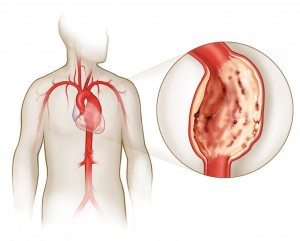What You Need To Know
By Gino, Sedillo, MD, FACC, CardioVascular Solutions Institute –


Atherosclerosis occurs when arteries that carry blood to your heart, head, organs, or limbs become narrowed or blocked by a buildup of plaque. Plaque can be made up of several things such as cholesterol, fatty substances, blood cells, and scar tissue. Atherosclerosis can lead to serious problems, including heart attack, stroke, or even death. When atherosclerosis occurs in the arteries carrying blood to the brain it is called cerebro/vascular disease (CVD). When it occurs in the arteries carrying blood to the heart it is called coronary artery disease (CAD). When atherosclerosis occurs in the arteries carrying blood to the extremities, it is called peripheral artery/vascular disease (PAD or PVD).
Cerebro/Vascular Disease (CVD)
CVD is the term used to describe atherosclerosis of the blood vessels that carry blood to the brain. Blockage of these vessels can lead to a stroke. Many of these blockages can be treated, therefore patients felt to be at risk should have a screening (carotid) ultrasound. Treatment Options: • Open Surgery – Carotid Endarterectomy (CEA) • Carotid Stenting – performed through a small puncture in the groin (femoral artery) with a filter device that is advanced prior to placing a stent. Very high success rate with low complications. Coronary Artery Disease (CAD) When blood vessels to the heart develop blockage (atherosclerosis), chest pain and possibly a heart attack can occur. Stress Tests and Cardiac Catheterizations can help us find these blockages.
Treatment Options:
- Medical Treatment alone
- Coronary Artery Bypass Surgery (for more advanced disease)
- Coronary Angioplasty/Stenting. Most blockages can be treated this way
Peripheral Artery/Vascular Disease (PAD or PVD)
When the arteries that supply blood to your arms, legs, kidneys, or intestines develop blockage it is called PAD or PVD. The most common place for PAD is in the arteries that provide blood flow to your lower extremities. With PAD, when the muscles of your legs and arms are working harder (such as during walking or exercise) there is not enough blood flow and oxygen secondary to blockage, causing discomfort, weakness or cramping in the legs. When peripheral arterial disease is more advanced, it can impair wound healing and cause discoloration to the feet and toes.
Treatment Options:
- Medical/Conservative Therapy (for mild disease)
- Surgical Bypass (for more advanced disease)
- Minimally invasive techniques such as plaque excision (atherectomy), balloon angioplasty, and stenting (most favored, less invasive, with good outcomes)
Abdominal Aortic Aneurysm (AAA)
An Abdominal Aortic Aneurysm is when the large blood vessel that supplies blood to the abdomen, pelvis, and legs (Aorta) becomes abnormally large or balloons outward, usually caused by a weakness in the artery wall. AAAs are usually very slow growing and do not cause any symptoms. Aneurysms of the aorta can rupture suddenly with a high likelihood of death. They are more common in people who have risk factors such as smoking history, high blood pressure, high cholesterol, male gender, or a family history of aneurysms. Abdominal Aortic Aneurysm can be screened for by a non-invasive testing such as an ultrasound. Once an Abdominal Aortic Aneurysm grows to a certain size or has rapid growth, it may need to be repaired.
Treatment Options:
- Open Surgery – Higher risk, longer recovery time
- Endovascular Aneurysm Repair (EVAR) – minimally invasive alternative to major open surgery, resulting in reduced recovery times and potentially improved survival rates. EVAR is performed using an Abdominal Aortic Aneurysm Stent Graft, and can be done through a small puncture in each groin (percutaneously). The AAA stent graft is placed within the aneurysm to provide a permanent, alternative conduit for blood flow within the patient’s vas- culature, thereby excluding the aneurysmal sac from blood flow and pressure and preventing the walls of the aneurysm from rupturing.
Call to schedule your appointment today:
Dr. Gino Sedillo, M.D. F.A.C.C.
941-747-8789
 Southwest Florida's Health and Wellness Magazine Health and Wellness Articles
Southwest Florida's Health and Wellness Magazine Health and Wellness Articles

